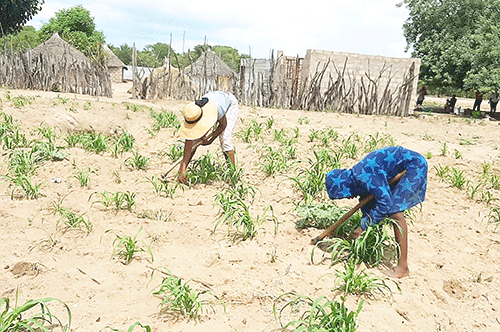OSHAKATI – In the face of devastating droughts that have gripped the northern regions, nearly 140 000 people in the rural Omusati have registered for the government’s drought relief programme.
According to Omusati Regional Council spokesperson Simion Kandjala, so far, 132 755 people have registered for the drought relief programme.
Namibia was hit by a dry spell between February and April.
This severely affected crops
and livestock, with some politicians and farmers’ unionists asking President Hage Geingob to declare a state of emergency.
“The number has accelerated from 74 841, and we are still expecting more, as we are not done with the assessment,” Kandjala said.
However, regional councillors and traditional leaders in northern regions are unhappy with the alleged slow pace of the drought relief programme.
According to the population and housing census of 2011, Omusati is the third highest populated region in the land, with 243 166 inhabitants.
According to the United Nations’ Food and Agriculture Organisation (FAO), an estimated 390 000 Namibians faced acute food insecurity between January and March 2023.
Exacerbating food insecurity were key factors, such as high food prices and localised adverse weather that induced severe shortfalls in cereal production in 2022.
This state of affairs was shared by FAO in its most recent crop prospects and quarterly global report on food.
Immanuel Shikongo from the Outapi constituency in the Omusati region complained that most of the people in his constituency are not benefitting from the relief, although they are faced with the same challenges as those who are getting.
The drought relief programme is mainly catered to the vulnerable Namibians, as well as those affected by natural calamities. Therefore, it is supposed to serve a crucial part in feeding all affected families and individuals.
Cabinet in April directed the Office of the Prime Minister (OPM) to extend the drought relief programme by the tune of N$121 million to Kunene, as well as parts of Erongo and Omusati. The programme runs from April to May 2024, according to existing criteria.
Hunger
Ompundja constituency councillor Adolf Hitler Uunona
said many people have started flocking to his office in search of drought relief food after their crops failed.
Uunona said hundreds of people from the Ompundja constituency in the Oshana region are in dire need of food aid because their crops withered due to erratic rains.
“The constituency has been receiving poor rainfall over the previous years, making it difficult for subsistence farmers who depend on mahangu and maize production to produce any food for their families,” he said.
Etayi constituency councillor Hans Haikali said more than 6 000 residents have enquired about the drought relief programme. “People are starving; they did not get anything from their crop fields. We have been waiting for the programme. The number of people keeps increasing,” he said.
Maria Petrus from Ompundja told New Era they have not received any drought relief or food aid, although they are registered, adding they were starving, as a majority of them are without jobs. “The government must do something. We are starving, and we will appreciate the little they can provide, as many of us are not working. Some, who are fortunate, survive on pension and social grants, while the rest are suffering,” said Petrus. Another resident Leena Shipombo said the government should do something before they die of hunger. “The government is well informed on what happened to our crop fields due to flooding and low rainfall,” she added. Saara Shoolongela from Ehafo LyaKandenge’s field looks like many others – stunted and wilted mahangu in a dusty field, scorched by the sun.
“I rely on my crops for the main food security for my family – and usually, I don’t have to buy mahangu. Now, I have no food to put on the table. It is devastating,” stressed Shoolongela. “We put a lot of work into the field, but the result is zero. It is demoralising and worrying.”
Martha Namwandi from the same area reports a less gloomy situation. Oshana governor Elia Irimari said the regional council will respond once all the required data are gathered. He, however, maintained there are already measures in place to help those who are affected.
“We cannot talk about mahangu. The situation appears to be dire. The worrying factor is that food is incredibly expensive, and people are already struggling with affordability,” the governor said. Oshikoto Regional Council spokesperson Petrus Nehale said no harvests are anticipated in most areas of the region. According to him, the looming drought is a “double-edged sword” to his region, as many constituencies are already struggling with water scarcity.
Ohangwena region could not give the exact number of people, as they were not done with the assessment.
Ohangwena was the most affected region by the flood, and many farmers’ crops were destroyed. The OPM said regional leaders and OPM officials are gathered at Oshakati for data collection in the regions to determine the food security status in those regions. - vkaapanda@nepc.com.na


